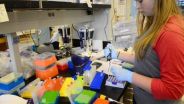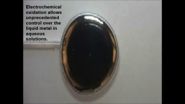(Press-News.org) When this week's print issue of the journal Science comes out, a collective cheer will go up from New Mexico, Montana and even the Netherlands, thanks to the type of collaborative effort that is more and more the norm in these connected times. Yes, the research was brilliant, and if we're lucky, it will produce innovations in biology, medicine, biotechnology and agriculture. It could save lives, and it happened because this scientist talked with that one, that one knew another one, and brilliant minds overcame geographic distance to advance human understanding.
"It is tremendously exciting working with researchers around the world, helping them apply the software and algorithms that we have developed to see the inner workings of molecular machines," said Thomas Terwilliger, a senior Los Alamos scientist and Laboratory Fellow.
In this case, researchers at Montana State University have provided the first blueprint of a bacterium's "molecular machinery," showing how bacterial immune systems fight off the viruses that infect them. By tracking down how bacterial defense systems work, the scientists can potentially fight infectious diseases and genetic disorders. The key is a repetitive piece of DNA in the bacterial genome called a CRISPR, for Clustered Regularly Interspaced Short Palindromic Repeats.
The bacterial genome uses the CRISPR to capture and "remember" the identity of an attacking virus, and now the scientists have created programmable molecular scissors, called nucleases, that are being exploited for precisely altering the DNA sequence of almost any cell type of interest.
The Los Alamos National Laboratory connection is the development of some terrifically clever software, called SOLVE/RESOLVE and PHENIX, in the protein structure analysis of the nuclease. That, connected with the science-community outreach whereby Los Alamos worked directly with structural biologists worldwide on their problems, helped it all come together. Determining the structure of the nuclease is key to understanding its function.
Los Alamos creates advanced algorithms for determining the structures of proteins and other macromolecules, and the software that makes these algorithms easy to use for thousands of structural biologists worldwide. The Laboratory partners with Lawrence Berkeley National Laboratory, Duke and Cambridge universities to create Phenix, a user-friendly and comprehensive software system that guides users through all the complicated steps necessary to determine the 3-D structure of their macromolecule.
"One of the best parts of working on the Phenix software is that there is a close-knit team of 15 researchers who work closely together, emailing each other many times every day, to make the software work as smoothly and effectively as possible," said Terwilliger.
"Some 13,000 scientific papers have used our SOLVE/RESOLVE and Phenix software," Terwilliger said, and Los Alamos researchers teach crystallographic methods and software tips extensively at scores of workshops around the world. The software licenses, through technology transfer programs, have generated approximately $3M in licensing revenue.
With the new Montana-based research, "therapies that were unimaginable may be possible in the future," said Blake Wiedenheft, senior author of the paper and assistant professor in MSU's Department of Microbiology and Immunology. "We know the genetic basis for many plant, animal, and human diseases, and these CRISRP-associated nucleases are now being used in research settings to surgically remove or repair defective genes."
INFORMATION:
Funding: Research in the Wiedenheft lab is supported by the National Institutes of Health, the National Science Foundation EPSCoR, the M.J. Murdock Charitable Trust, and the MSU Agricultural Experimental Station. Atomic coordinates for the Cascade structure have been deposited into the public repository (Protein Data Bank) under access code 4TVX.
Journal reference: Ryan N. Jackson, Sarah M. Golden, Paul B. G. Van Erp, Joshua Carter, Edze R. Westra, Stan J. J. Brouns, John Van Der Oost, Thomas C. Terwilliger, Randy J. Read, Blake Wiedenheft. Crystal structure of the CRISPR RNA–guided surveillance complex from Escherichia coli. Science, 2014 DOI: 10.1126/science.1256328
PDF
About Los Alamos National Laboratory
Los Alamos National Laboratory, a multidisciplinary research institution engaged in strategic science on behalf of national security, is operated by Los Alamos National Security, LLC, a team composed of Bechtel National, the University of California, The Babcock & Wilcox Company, and URS for the Department of Energy's National Nuclear Security Administration.
Los Alamos enhances national security by ensuring the safety and reliability of the U.S. nuclear stockpile, developing technologies to reduce threats from weapons of mass destruction, and solving problems related to energy, environment, infrastructure, health, and global security concerns.
Collaboration drives achievement in protein structure research
By tracking down how bacterial defense systems work, the scientists can potentially fight infectious diseases and genetic disorders
2014-09-15
ELSE PRESS RELEASES FROM THIS DATE:
Certain form of baldness at age 45 linked to higher risk of aggressive prostate cancer
2014-09-15
A new, large cohort analysis from the prospective Prostate, Lung, Colorectal and Ovarian (PLCO) Cancer Screening Trial, indicates that men who had moderate baldness affecting both the front and the crown of their head at age 45 were at a 40% increased risk of developing aggressive prostate cancer (usually indicates a faster growing tumor resulting in poorer prognosis relative to non-aggressive prostate cancer) later in life, compared to men with no baldness. There was no significant link between other patterns of baldness and prostate cancer risk. The study, published September ...
Researcher develops and proves effectiveness of new drug for spinal muscular atrophy
2014-09-15
COLUMBIA, Mo. – According to recent studies, approximately one out of every 40 individuals in the United States is a carrier of the gene responsible for spinal muscular atrophy (SMA), a neurodegenerative disease that causes muscles to weaken over time. Now, researchers at the University of Missouri have made a recent breakthrough with the development of a new compound found to be highly effective in animal models of the disease. In April, a patent was filed for the compound for use in SMA.
"The strategy our lab is using to fight SMA is to 'repress the repressor,'" said ...
EEG study findings reveal how fear is processed in the brain
2014-09-15
DALLAS, TX – September 12, 2014 - An estimated 8% of Americans will suffer from post traumatic stress disorder (PTSD) at some point during their lifetime. Brought on by an overwhelming or stressful event or events, PTSD is the result of altered chemistry and physiology of the brain. Understanding how threat is processed in a normal brain versus one altered by PTSD is essential to developing effective interventions.
New research from the Center for BrainHealth at The University of Texas at Dallas published online today in Brain and Cognition illustrates how fear arises ...
Smithsonian scientists discover tropical tree microbiome in Panama
2014-09-15
Human skin and gut microbes influence processes from digestion to disease resistance. Despite the fact that tropical forests are the most biodiverse terrestrial ecosystems on the planet, more is known about belly-button bacteria than bacteria on trees in the tropics. Smithsonian scientists and colleagues working on Panama's Barro Colorado Island discovered that small leaf samples from a single tree were home to more than 400 different kinds of bacteria. The combined sample from 57 tree species contained more than 7,000 different kinds.
Bacteria in tropical forests may ...
Scientists discover RNA modifications in some unexpected places
2014-09-15
CAMBRIDGE, Mass. (September 15, 2014) – The so-called central dogma of molecular biology—that DNA makes RNA which makes protein—has long provided a simplified explanation for how genetic information is deciphered and translated in living organisms.
In reality, of course, the process is vastly more complicated than the schema first articulated nearly 60 years ago by Nobel Laureate Francis Crick, co-discoverer of the DNA's double-helix structure. For one, there are multiple types of RNA, three of which—messenger RNA (mRNA), transfer RNA (tRNA), and ribosomal RNA (rRNA)—are ...
Study first to use brain scans to forecast early reading difficulties
2014-09-15
UC San Francisco researchers have used brain scans to predict how young children learn to read, giving clinicians a possible tool to spot children with dyslexia and other reading difficulties before they experience reading challenges.
In the United States, children usually learn to read for the first time in kindergarten and become proficient readers by third grade, according to the authors. In the study, researchers examined brain scans of 38 kindergarteners as they were learning to read formally at school and tracked their white matter development until third grade. ...
'Femme fatale' emerald ash borer decoy lures and kills males
2014-09-15
An international team of researchers has designed decoys that mimic female emerald ash borer beetles and successfully entice male emerald ash borers to land on them in an attempt to mate, only to be electrocuted and killed by high-voltage current.
"Our new decoy and electrocution process may be useful in managing what the U.S. Department of Agriculture Forest Service claims to be the most destructive forest pest ever seen in North America," said Michael Domingue, postdoctoral fellow in entomology, Penn State.
According to the Forest Service, the emerald ash borer was ...
Researchers control surface tension to manipulate liquid metals
2014-09-15
VIDEO:
Liquid metals have very large surface tensions that causes them to assume a spherical shape. Researchers have shown that the deposition of a surface oxide lowers the surface tension...
Click here for more information.
Researchers from North Carolina State University have developed a technique for controlling the surface tension of liquid metals by applying very low voltages, opening the door to a new generation of reconfigurable electronic circuits, antennas and other ...
Neuroscientists identify key role of language gene
2014-09-15
CAMBRIDGE, MA -- Neuroscientists have found that a gene mutation that arose more than half a million years ago may be key to humans' unique ability to produce and understand speech.
Researchers from MIT and several European universities have shown that the human version of a gene called Foxp2 makes it easier to transform new experiences into routine procedures. When they engineered mice to express humanized Foxp2, the mice learned to run a maze much more quickly than normal mice.
The findings suggest that Foxp2 may help humans with a key component of learning language ...
Network measures predict neuropsychological outcome after brain injury
2014-09-15
Cognitive neuroscience research has shown that certain brain regions are associated with specific cognitive abilities, such as language, naming, and decision-making.
How and where these specific abilities are integrated in the brain to support complex cognition is still under investigation. However, researchers at the University of Iowa and Washington University in St. Louis, Missouri, believe that several hub regions may be especially important for the brain to function as an integrated network.
In research published online Sept. 15 in the Early Edition of the Proceedings ...
LAST 30 PRESS RELEASES:
Artificial intelligence to be used for the detection of common eye disease
A roadmap for digital neuroscience
Radiologists propose actions to combat climate change
SwRI to discuss connected vehicle data exchanges, AI tools at 2024 ITS America Conference & Expo
Announcing the second cohort of the Hevolution/AFAR new investigator awardees in aging biology and geroscience research
Advances in understanding the evolution of stomach loss in agastric fishes
Social media affects people’s views on mental illness
Aerogel-based PCMs improve thermal management, reduce microwave emissions in electronic devices
Undernourished household members at increased risk for developing TB after exposure
A non-equivalent co-doped strategy to effectively improve the electrical properties of BIT-based high-temperature piezoelectric ceramics
RAMP1 protects hepatocytes against ischemia-reperfusion injury by inhibiting the ERK/YAP pathway
Molecular mechanism of chemical diversity of thermophilic fungus and its ecological and biological functions
Engaging pharmacists to improve atrial fibrillation care
Exploring brain synchronization patterns during social interactions
Unveiling the molecular functions of lipid droplet proteins in Arabidopsis thaliana leaves
Perfecting the view on a crystal’s imperfection
Fossil frogs share their skincare secrets
Existing drugs studied in patients with rare immune diseases
Loma Linda University study reveals alarming rates of pediatric injuries from mechanical bull riding
Excessive pregnancy weight gain and substantial postpartum weight retention common in military health care beneficiaries
Odor-causing bacteria in armpits targeted using bacteriophage-derived lysin
Women’s heart disease is underdiagnosed, but new machine learning models can help solve this problem
Extracting high-purity gold from electrical and electronic waste
Tropical fish are invading Australian ocean water
No bull: How creating less-gassy cows could help fight climate change
ECU researchers call for enhanced research into common post-stroke condition
SharpeRatio@k: novel metric for evaluation of risk-return tradeoff in off-policy evaluation
$1.8M NIH grant will help researchers follow a virus on its path to the nucleus
Follow-up 50 years on finds landmark steroid study remains safe
Active military service may heighten women’s risk of having low birthweight babies
[Press-News.org] Collaboration drives achievement in protein structure researchBy tracking down how bacterial defense systems work, the scientists can potentially fight infectious diseases and genetic disorders



